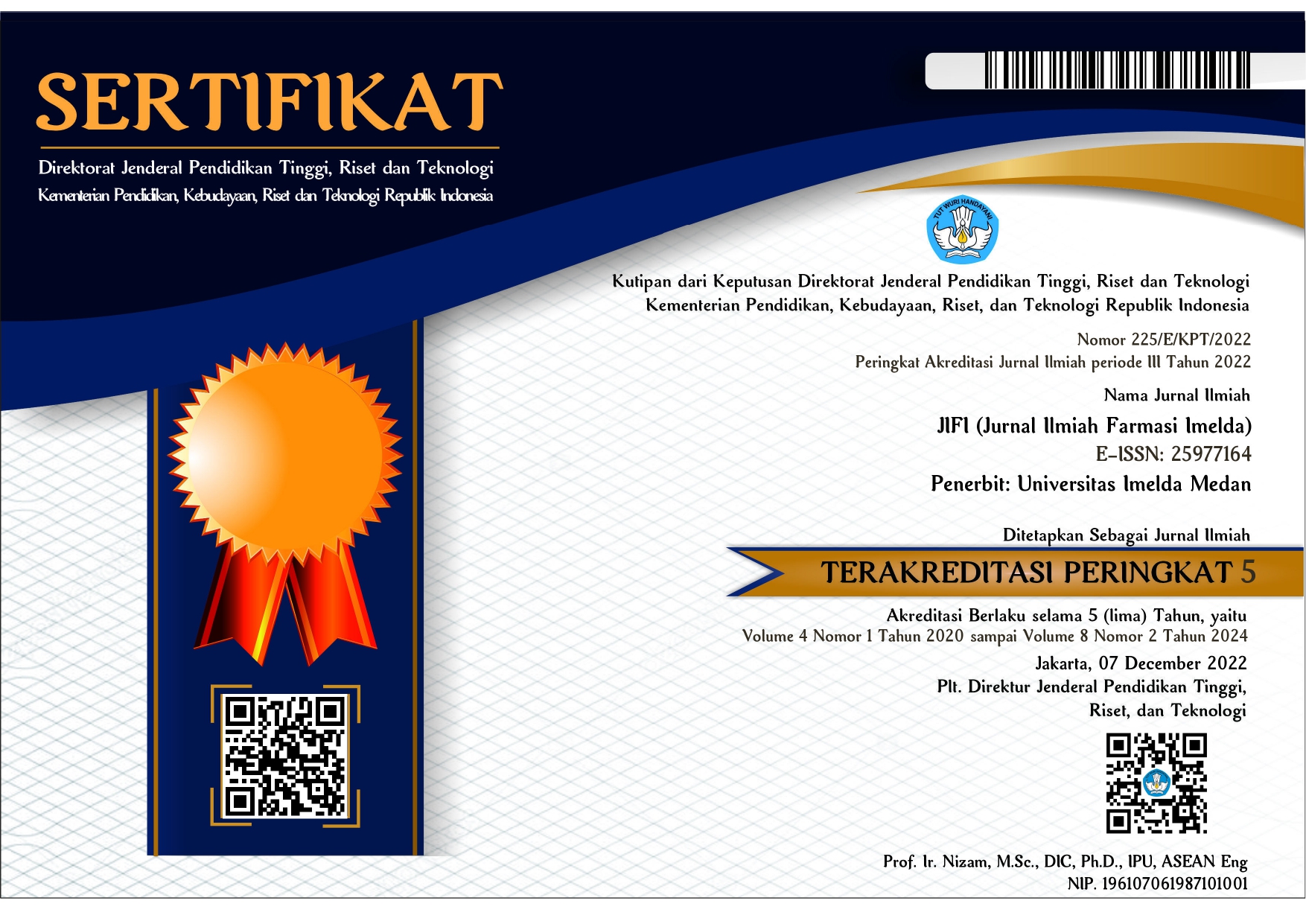DOCKING SINERGIS ALLICIN, ALLIIN, DAN DIALLYL SULFIDE TERHADAP RESEPTOR ESTROGEN ALFA PADA KANKER PAYUDARA
DOI:
https://doi.org/10.52943/jifarmasi.v9i1.1982Keywords:
molecular docking, garlic compounds, estrogen receptor alpha, breast cancer, synergistic bindingReferences
An, K.-C. (2016). Selective Estrogen Receptor Modulators. Asian Spine Journal, 10(4), 787–791. https://doi.org/10.4184/asj.2016.10.4.787
Arunkumar, M., Mahalakshmi, M., Ashokkumar, V., Aravind, M. K., Gunaseelan, S., Mohankumar, V., Ashokkumar, B., & Varalakshmi, P. (2022). Evaluation of seaweed sulfated polysaccharides as natural antagonists targeting Salmonella typhi OmpF: molecular docking and pharmacokinetic profiling. Beni-Suef University Journal of Basic and Applied Sciences, 11(1). https://doi.org/10.1186/s43088-021-00192-x
Garrett M. Morris. (2010). AutoDock Version 4.2 - User Guide. Guide, 1–49.
Hirata, Y., Nagase, H., Satoh, K., Takemori, H., Furuta, K., & Kamatari, Y. O. (2025). Antiferroptotic properties of allicin and related organosulfur compounds—diallyl disulfide and diallyl trisulfide—from Garlic. Food and Chemical Toxicology, 195, 115124. https://doi.org/https://doi.org/10.1016/j.fct.2024.115124
Jiménez, J. S., & Benítez, M. J. (2024). Gibbs Free Energy and Enthalpy–Entropy Compensation in Protein–Ligand Interactions. Biophysica, 4(2), 298–309. https://doi.org/10.3390/biophysica4020021
Kang, J. G., & Park, C. Y. (2012). Anti-obesity drugs: A review about their effects and safety. Diabetes and Metabolism Journal, 36(1), 13–25. https://doi.org/10.4093/dmj.2012.36.1.13
Lateef, T., Naeem, S., & Qureshi, S. A. (2020). In-silico studies of HMG-Co A reductase inhibitors present in fruits of Withania coagulans Dunal (Solanaceae). Tropical Journal of Pharmaceutical Research, 19(2), 305–312. https://doi.org/10.4314/tjpr.v19i2.13
Mag, P., Mansingh, D. P., Dalpati, N., Sali, V. K., & Vasanthi, A. H. R. (2018). Alliin the Precursor of Allicin in Garlic Extract Mitigates Proliferation of Gastric Adenocarcinoma Cells by Modulating Apoptosis. 84–91. https://doi.org/10.4103/pm.pm
Malla, R., Marni, R., Chakraborty, A., & Kamal, M. A. (2022). Diallyl disulfide and diallyl trisulfide in garlic as novel therapeutic agents to overcome drug resistance in breast cancer. Journal of Pharmaceutical Analysis, 12(2), 221–231. https://doi.org/10.1016/j.jpha.2021.11.004
Miñarro-Lleonar, M., Ruiz-Carmona, S., Alvarez-Garcia, D., Schmidtke, P., & Barril, X. (2022). Development of an Automatic Pipeline for Participation in the CELPP Challenge. International Journal of Molecular Sciences, 23(9). https://doi.org/10.3390/ijms23094756
Nakamoto, M., Kunimura, K., Suzuki, J.-I., & Kodera, Y. (2020). Antimicrobial properties of hydrophobic compounds in garlic: Allicin, vinyldithiin, ajoene and diallyl polysulfides. Experimental and Therapeutic Medicine, 19(2), 1550–1553. https://doi.org/10.3892/etm.2019.8388
Pantsar, T., & Poso, A. (2018). Binding Affinity via Docking: Fact and Fiction. Molecules (Basel, Switzerland), 23(8). https://doi.org/10.3390/molecules23081899
Rim, K. T. (2020). In silico prediction of toxicity and its applications for chemicals at work. Toxicology and Environmental Health Sciences, 12(3), 191–202. https://doi.org/10.1007/s13530-020-00056-4
Schön, A., Madani, N., Smith, A. B., Lalonde, J. M., & Freire, E. (2011). Some binding-related drug properties are dependent on thermodynamic signature. Chemical Biology & Drug Design, 77(3), 161–165. https://doi.org/10.1111/j.1747-0285.2010.01075.x
Sharma, D., Kumar, S., & Narasimhan, B. (2018). Estrogen alpha receptor antagonists for the treatment of breast cancer: A review. Chemistry Central Journal, 12(1), 1–32. https://doi.org/10.1186/s13065-018-0472-8
Shivanika, C., Deepak Kumar, S., Ragunathan, V., Tiwari, P., Sumitha, A., & Brindha Devi, P. (2022). Molecular docking, validation, dynamics simulations, and pharmacokinetic prediction of natural compounds against the SARS-CoV-2 main-protease. Journal of Biomolecular Structure and Dynamics, 40(2), 585–611. https://doi.org/10.1080/07391102.2020.1815584
Talib, W. H., Baban, M. M., Azzam, A. O., Issa, J. J., Ali, A. Y., AlSuwais, A. K., Allala, S., & AL Kury, L. T. (2024). Allicin and Cancer Hallmarks. Molecules, 29(6). https://doi.org/10.3390/molecules29061320
Yanti, S., Chien, W.-J., & Agrawal, D. C. (2022). Profiling of insulin and resveratrol interaction using multi-spectroscopy and molecular docking study. Beni-Suef University Journal of Basic and Applied Sciences, 11(1), 90. https://doi.org/10.1186/s43088-022-00269-1
Yue, W., Yager, J. D., Wang, J. P., Jupe, E. R., & Santen, R. J. (2013). Estrogen receptor-dependent and independent mechanisms of breast cancer carcinogenesis. Steroids, 78(2), 161–170. https://doi.org/10.1016/j.steroids.2012.11.001
Zloh, M., & Kirton, S. B. (2018). The benefits of in silico modeling to identify possible small-molecule drugs and their off-target interactions. Future Medicinal Chemistry, 10(4), 423–432. https://doi.org/10.4155/fmc-2017-0151
Downloads
Published
Issue
Section
License
Copyright (c) 2025 JIFI (Jurnal Ilmiah Farmasi Imelda)

This work is licensed under a Creative Commons Attribution-NonCommercial 4.0 International License.








